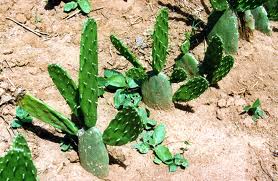 Cactus long despised by many due to its thorny aspects is now emerging as a solution to feeding African livestock during drought, based on findings by scientists at the Kenya Agricultural Research Institute (KARI). A research paper by animal nutritionist John Kang'ara and Agraonomist Josiah Gitari at KARI stated that the prickly pear or paddle cacti (Opuntia) serves as an excellent source of water and nutrition in harsh conditions.
Cactus long despised by many due to its thorny aspects is now emerging as a solution to feeding African livestock during drought, based on findings by scientists at the Kenya Agricultural Research Institute (KARI). A research paper by animal nutritionist John Kang'ara and Agraonomist Josiah Gitari at KARI stated that the prickly pear or paddle cacti (Opuntia) serves as an excellent source of water and nutrition in harsh conditions.
The Opuntia variety remains green and succulent, contains about 90 per cent moisture, and is easily digestible even in times of extreme water shortages, the research revealed. It can also be used for for water purification, and as food for humans during famine.
Presenting their findings at the 'Pastoralism and Climate Change Adaptation in Africa conference', the scientists said: "Despite its fodder potential, cactus is an underutilised fodder resource in Kenya and other East African countries due to lack of information on its nutritive value and other benefits."
During a severe famine in 2008–2009, farmers who fed their cattle cactus paddles lost none of their cattle, dispelling the age-old belief that the cactus kills livestock. Moreover, farmers in Laikipia East frequently feed their livestock cactus during drought with no harm to the livestock. Maasai pastoralists, however, have refused to use the cactus as feed and have even requested the government to eradicate what they consider to be an invading weed.
However, under programmes funded by the Kenyan government and KARI, farmers and agricultural extension officers are now being educated about the benefits of cactus as fodder, said Kang'ara and Gitari. The next stage will be research on the best agronomic practices for wide-scale planting of the cactus and testing of the spiny and spineless varieties growing wild in Kenya to determine which are most suited for farming in the country, they said.
The spiny types pose challenges due to the damage they can inflict on animals' alimentary tracts. Farmers using them as fodder first remove the spines by burning or scrapping them with a machete before giving them to animals.
But based on the nutrition findings, the cultivation of cactus as livestock feed in marginal production areas, rangelands, and arid and semi-arid areas should be encouraged, the Kenyan scientists stressed. The plant can produce a large quantity of green forage throughout the year if properly managed.
“These plants have potential to withstand even the harshest of climate, we have tried various measures targeting pastoralists including telling them to sell their livestock during drought but they would rather die than do that. So we have to come up with practical solutions to protect the pastoralists and their livestock, and this is one very interesting way,” said Kang'ara.
Kang'ara and Gitari also urged regional government to develop cactus plantations. The scientists are now trialling cultivation and feeding of livestock in arid areas with an aim of rolling it out across the country.
















Comments powered by CComment